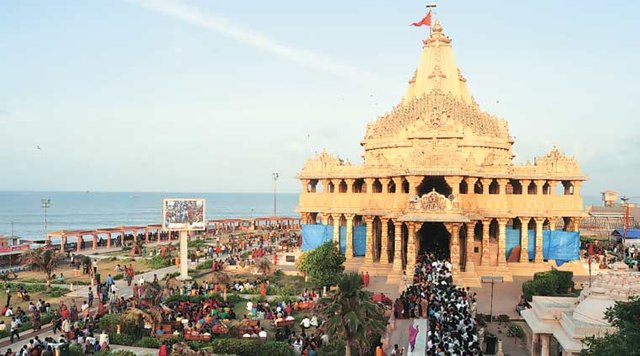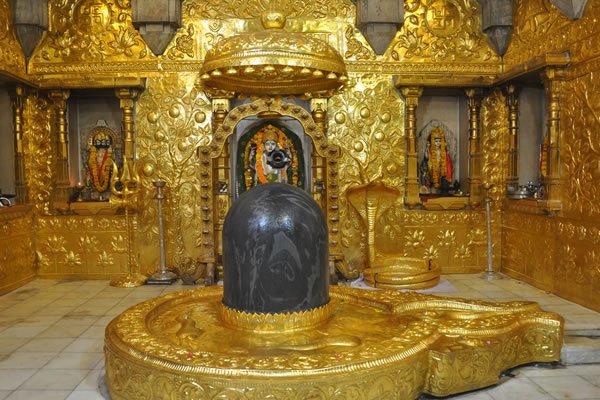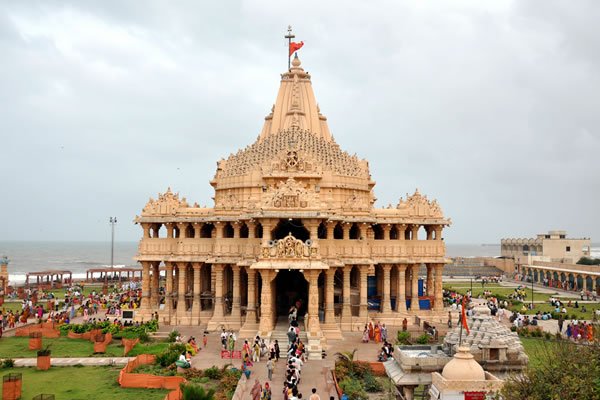All you want to know about Mysterious SOMNATH TEMPLE - INDIA

The Somnath temple located in Prabhas Patan near Veraval in Saurashtra on the western coast of Gujarat, is believed to be the first among the twelve jyotirlinga shrines of Shiva. It is an important pilgrimage and tourist spot of Gujarat. Destroyed and reconstructed several times in the past, the present temple was reconstructed in Chaulukya style of Hindu temple architecture and completed in May 1951.
The temple is considered sacred due to the various legends connected to it. Somnath means "Lord of the Soma", an epithet of Shiva.
According to tradition, the Shivalinga in Somnath is one of the twelve jyotirlingas in India, where Shiva is believed to have appeared as a fiery column of light. The jyotirlingas are taken as the supreme, undivided reality out of which Shiva partly appears.
Each of the twelve jyotirlinga sites take the name of a different manifestation of Shiva. At all these sites, the primary image is a lingam representing the beginning-less and endless stambha (pillar), symbolizing the infinite nature of Shiva. In addition to the one at Somnath, the others are at Varanasi, Rameswaram, Dwarka, Somnath, Nageshwar, Trimbakeshwar, Grishneshwar, Aundha Nagnath, Parli Baidyanath, Rameshwaram, Omkareshwar, Kedarnath
The site of Somnath has been a pilgrimage site from ancient times on account of being a Triveni sangam (the confluence of three rivers — Kapila, Hiran and the mythical Sarasvati). Soma, the Moon god, is believed to have lost his lustre due to a curse, and he bathed in the Sarasvati River at this site to regain it. The result is the waxing and waning of the moon, no doubt an allusion to the waxing and waning of the tides at this sea shore location. The name of the town Prabhas, meaning lustre, as well as the alternative names Someshvar and Somnath ("The lord of the moon" or "the moon god") arise from this tradition.
History of the temple

According to popular tradition documented by J. Gordon Melton, the first Siva temple at Somanath is believed to have been built at some unknown time in the past. The second temple is said to have been built at the same site by the "Yadava kings" of Vallabhi around 649 CE. In 725 CE, Al-Junayd, the Arab governor of Sindh is said to have destroyed the second temple as part of his invasions of Gujarat and Rajasthan. The Gurjara-Pratihara king Nagabhata II is said to have constructed the third temple in 815 CE, a large structure of red sandstone.
However, there is no historical record of an attack on Somnath by Al-Junayd. Nagabhata II is known to have visited tirthas in Saurashtra, including Someshvara (the Lord of the Moon), which may or may not be a reference to a Siva temple because the town itself was known by that name. The Chaulukya (Solanki) king Mularaja possibly built the first temple at the site sometime before 997 CE, even though some historians believe that he may have renovated a smaller earlier temple.
In 1024, during the reign of Bhima I, the prominent Turkic ruler Mahmud of Ghazni raided Gujarat, plundering the Somnath temple and breaking its jyotirlinga. He took away a booty of 20 million dinars. Historians expect the damage to the temple by Mahmud to have been minimal because there are records of pilgrimages to the temple in 1038, which make no mention of any damage to the temple. However, powerful legends with intricate detail developed in the Turko-Persian literature regarding Mahmud's raid, which "electrified" the Muslim world according to scholar Meenakshi Jain. They later boasted that Mahmud had killed 50,000 devotees who tried to defend the temple.
The temple at the time of Mahmud's attack appears to have been a wooden structure, which is said to have decayed in time (kalajirnam). Kumarapala (r. 1143–72) rebuilt it in "excellent stone and studded it with jewels," according to an inscription in 1169. During its 1299 invasion of Gujarat, Alauddin Khalji's army, led by Ulugh Khan, defeated the Vaghela king Karna, and sacked the Somnath temple. Legends in the later texts Kanhadade Prabandha (15th century) and Khyat (17th century) state that the Jalore ruler Kanhadadeva later recovered the Somnath idol and freed the Hindu prisoners, after an attack on the Delhi army near Jalore. However, other sources state that the idol was taken to Delhi, where it was thrown to be trampled under the feet of Muslims. These sources include the contemporary and near-contemporary texts including Amir Khusrau's Khazainul-Futuh, Ziauddin Barani's Tarikh-i-Firuz Shahi and Jinaprabha Suri's Vividha-tirtha-kalpa. It is possible that the story of Kanhadadeva's rescue of the Somnath idol is a fabrication by the later writers. Alternatively, it is possible that the Khalji army was taking multiple idols to Delhi, and Kanhadadeva's army retrieved one of them.
The temple was rebuilt by Mahipala I, the Chudasama king of Saurashtra in 1308 and the lingam was installed by his son Khengara sometime between 1331 and 1351.[29] As late as the 14th century, Gujarati Muslim pilgrims were noted by Amir Khusrow to stop at that temple to pay their respects before departing for the Hajj pilgrimage.
In 1395, the temple was destroyed for the third time by Zafar Khan, the last governor of Gujarat under the Delhi Sultanate and later founder of Gujarat Sultanate.[31] In 1451, it was desecrated by Mahmud Begada, the Sultan of Gujarat.
In 1546, the Portuguese, based in Goa, attacked ports and towns in Gujarat including Somnath and destroyed several temples and mosques.
By 1665, the temple, one of many, was ordered to be destroyed by Mughal emperor Aurangzeb. In 1702, he ordered that if Hindus revived worship there, it should be demolished completely.
During olden times if extended to the present Sun temple Sheetla. It's still evident from the temple of Sun God Nagradil the population of which was known as 'Nagrapur'. Here the rivers Triveni Ganga and Hiranya Sarita had stone lined banks or ghats. Archeological explorational excavation carried out several years ago had discovered pre-vedic era specimens.
Archeological examinations have concluded, beginning, rise and fall of more than 500 civilizations. According to historians, during prehistoric times the place was populated by 'Meenurs'. From here goods were traded between several Asian ports, both exporting and importing there.
'Proclamation of the Gates' incident during the British period
In 1782-83 AD, Maratha king Mahadaji Shinde, victoriously brought back three silver gates from Lahore after defeating Mahmud Shah Abdati, to Somnath. After refusal from priests of Gujarat and the then ruler Gaekwad to put them back on Somnath temple, these silver gates were placed in the temples of Ujjain. Today they can be seen in two temples of India, Mahakaleshwar Jyotirlinga and Gopal Mandir of Ujjain.
In 1842, Edward Law, 1st Earl of Ellenborough issued his Proclamation of the Gates, in which he ordered the British army in Afghanistan to return via Ghazni and bring back to India the sandalwood gates from the tomb of Mahmud of Ghazni in Ghazni, Afghanistan. These were believed to have been taken by Mahmud from Somnath. Under Ellenborough's instruction, General William Nott looted the gates in September 1842. A whole sepoy regiment, the 43rd Bengal Native Infantry, was detailed to carry the gates back to India in triumph. However, on arrival, they were found not to be of Gujarati or Indian design, and not of Sandalwood, but of Deodar wood (native to Ghazni) and therefore not authentic to Somnath. They were placed in the arsenal store-room of the Agra Fort where they still lie to the present day. There was a debate in the House of Commons in London in 1843 on the question of the gates of the temple and Ellenbourough's role in the affair. After much crossfire between the British Government and the opposition, all of the facts as we know them were laid out.
In the 19th century novel The Moonstone by Wilkie Collins, the diamond of the title is presumed to have been stolen from the temple at Somnath and, according to the historian Romila Thapar, reflects the interest aroused in Britain by the gates.
Reconstruction during 1950–1951
K.M. Munshi with archaeologists and engineers of the Government of India, Bombay and Saurashtra, with the ruins of Somnath Temple in the background, July 1950.
Before independence, Prabhas Patan was part of the princely state of Junagadh, whose ruler had acceded to Pakistan in 1947. After India refused to accept his decision, the state was made a part of India and Deputy Prime Minister Patel came to Junagadh on 12 November 1947 to direct the stabilization of the state by the Indian Army and at the same time ordered the reconstruction of the Somnath temple.
When Patel, K. M. Munshi and other leaders of the Congress went to Mahatma Gandhi with their proposal to reconstruct the Somnath temple, Gandhi blessed the move, but suggested that the funds for the construction should be collected from the public and the temple should not be funded by the state. He expressed that he was proud to associate himself to the project of renovation of the temple. However, soon both Gandhi and Sardar Patel died and the task of reconstruction of the temple continued under Munshi, who was the Minister for Food and Civil Supplies, Government of India headed by Prime Minister Jawaharlal Nehru.
The ruins were pulled down in October 1950 and the mosque present at that site was shifted few kilometres away. In May 1951, Rajendra Prasad, the first President of the Republic of India, invited by K M Munshi, performed the installation ceremony for the temple.The President said in his address, "It is my view that the reconstruction of the Somnath Temple will be complete on that day when not only a magnificent edifice will arise on this foundation, but the mansion of India's prosperity will be really that prosperity of which the ancient temple of Somnath was a symbol.". He added "The Somnath temple signifies that the power of reconstruction is always greater than the power of destruction."
Architecture of the present temple[edit]
Bāṇastambha (Arrow Pillar)
The present temple is built in the Chalukya style of temple architecture or "Kailash Mahameru Prasad" styleand reflects the skill of the Sompura Salats, one of Gujarat's master masons. The temple's śikhara, or main spire, is 15 metres in height, and it has an 8.2-metre tall flag pole at the top.
The temple is situated at such a place that there is no land in a straight line between Somnath seashore until Antarctica, such an inscription in Sanskrit is found on the Bāṇastambha (Sanskrit: बाणस्तम्भ, lit. arrow pillar) erected on the sea-protection wall. The Bāṇastambha mentions that it stands at a point on the Indian landmass that is the first point on land in the north to the South Pole at that particular longitude.
Interesting Facts about Somnath Temple
One of the 12 Jyotirlingas Shrines of Shiva, Somnath Temple is also the specimen of fine architecture. Dubbed as Eternal Shrine, it is believed to be the place where Lord Krishna ended his Lila and thereafter for heavenly abode. This legendary temple is said to have vandalized numerous times in the history but with the help of zealot Hindu Kings the temple was rebuilt each time. Here in this blog we bring to you facts and legends that are attached to this sacred and architecturally marvelous temple.
The modern day Somnath Temple was built over five years, from 1947 to 1951 and was inaugurated by then President of India Dr Rajendra Prasad.
The Shivalinga in the temple is believed to have been safely hiding within its hollowness the famous Syamantak Mani, the Philosopher’s stone, which is associated with Lord Krishna. It is said that it was a magical stone, which was capable of producing gold. It is also believed that stone had alchemic and radioactive properties and could create a magnetic field around itself that helped it remain floating above ground.

The temple finds its reference in the most ancient texts of Hindus like Shreemad Bhagavat, Skandpuran, Shivpuran and Rig-Veda which signifies the importance of this temple as one of the most popular pilgrimage sites in India.
According to history scholars, the site of Somnath has been a pilgrimage site from ancient times as it was said to be the confluence point known of three rivers, Kapila, Hiran and the mythical Saraswati. The confluence was called as Triveni Sangam and is believed to be the place where Soma, the Moon god bathed and regained his lustre. The result is reckoned to be the waxing and waning of the moon or the waxing and waning of the tides at this sea shore location.
The legend has it that the initial structure of the temple was first built by Moon God who constructed the temple with gold. The Sun God used silver for its construction, whereas Lord Krishna made it with the help of sandalwood.
According to Hindu scholar, Swami Gajanand Saraswati, the first temple was built 7, 99, 25,105 years ago as derived from the traditions of Prabhas Khand of Skand Puran.
The temple was suffer destruction at the hands of Mahmud Ghazni in 1024, Khilji’s army in 1296 , Muzaffar Shah in 1375, Mahmud Begada in 1451 and Aurangzeb in 1665.
The temple is said to be situated at such a place that there is no land in straight-line between Somnath seashore till Antarctica. In an inscription in Sanskrit, found on the Arrow-Pillar called Baan-Stambh erected on the sea-protection wall at the Somnath Temple is stated that the temple stands at a point on the Indian piece of land, which happens to be the first point on land in the north to the south-pole on that particular longitude.
According to Skanda Purana, the name of Somnath Temple will change every time the world is reconstructed. It is believed when Lord Brahma will create a new world after ending the recent one, Somnath will acquire the name of Pran Nath Temple.
On the walls of the temple, along with Shiva, the sculptures of Lord Brahma and Vishnu can also be seen. According to the Prabhaskhand of Skanda Purana, answering to the question of Parvati, Lord Shiva reveals that so far Somnath has been named 8 times.
According another reference in the Skanda Purana, there have been about 6 Brahmas. This is the era of 7th Brahma who is called Shatanand. Lord Shiva also reveals that in the 7th Yuga, the name of the temple is Somnath and in the last Yuga the Shivlinga was called Mrityunjay.